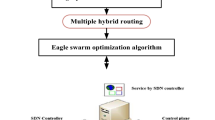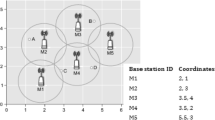Abstract
Internet of Things (IoT) is the recent technology emerged with new research ideas in the communication arena. With multiple sensors and actuators, it operates on limited energy for numerous applications and it requires major updates for data updating in the network. Mobility, redundancy, and bandwidth are the common factors used to measure the network performance. Data accessing using multihoming mechanism is used to enhance the network performance without any compromise in quality of service. Multi-homing is used to connect one or more devices into a heterogeneous multi-network by using IP address with a best routing strategy. Efficient routing in the multihoming mechanism develops a reliable network and provides a better power efficiency and QoS policy to the users. This proposed research work includes an efficient Ant Colony Optimization On-demand Multipath Distance Vector routing algorithm for enhancing power efficiency in multihoming mechanism based IoT. The proposed model highlights the best routing algorithm in terms of energy consumption and delay that is suitable in multihoming networks.







Similar content being viewed by others
References
Khatouni, A. S., Marsan, M. A., Mellia, M., & Rejaie, R. (2018). Deadline-constrained content upload from multihomed devices: Formulations and algorithms. Journal of Computer Networks, 142, 76–92.
Sun, Y., Zhang, Y., Fang, B., & Zhang, H. (2017). Succinct and practical greedy embedding for geometric routing. Journal of Computer Communications, 114, 51–61.
Manisekaran, S. V., & Venkatesan, R. (2016). An analysis of software-defined routing approach for wireless sensor networks. Journal of Computers and Electrical Engineering, 56, 456–467.
Huang, H., Zhang, J., Zhang, X., Yi, B., Fan, Q., & Li, F. (2017). EMGR: Energy-efficient multicast geographic routing in wireless sensor networks. Computer Network, 129, 51–63.
Jackson, C., & Hollis, S. J. (2011). A deadlock-free routing algorithm for dynamically reconfigurable Networks-on-Chip. Microprocessors and Microsystems, 35, 139–151.
Güney, E., Aras, N., Altınel, İ. K., & Ersoy, C. (2012). Efficient solution techniques for the integrated coverage, sink location and routing problem in wireless sensor networks. Journal of Computers & Operations Research, 39, 1530–1539.
Archetti, C., Fernández, E., & Huerta-Muñoz, D. L. (2017). The flexible periodic vehicle routing problem. Journal of Computers and Operations Research, 85, 58–70.
Osman, M. S., & Ram, B. (2017). Routing and scheduling on evacuation path networks using centralized hybrid approach. Journal of Computers and Operations Research, 88, 332–339.
Paraskevopoulos, D. C., Laporte, G., Repoussis, P. P., & Tarantilis, C. D. (2017). Resource constrained routing and scheduling: Review and research prospects. European Journal of Operational Research, 263, 737–754.
Zhang, X., & Da Wu, X. (2011). The balance of routing energy consumption in wireless sensor networks. Journal of Parallel Distributed Computing, 71, 1024–1033.
Mathura, A., Newea, T., Elgenaidia, W., Raoa, M., Doolya, G., & Toal, D. (2017). A secure end-to-end IoT solution. Journal of Sensors and Actuators, 263, 291–299.
Demircan, S., Aydin, M., & Durduran, S. S. (2011). Finding optimum route of electrical energy transmission line using multi-criteria with Q-learning. Journal of Expert Systems with Applications, 38, 3477–3482.
Khayou, H., & Sarakbi, B. (2017). A validation model for non-lexical routing protocols. Journal of Network and Computer Applications, 98, 58–64.
Güney, E., Aras, N., Altınel, İ. K., & Ersoy, C. (2010). Efficient integer programming formulations for optimum sink location and routing in heterogeneous wireless sensor networks. Journal of Computer Networks, 54, 1805–1822.
Santos, B. P., Vieira, L. F. M., & Vieira, M. A. M. (2017). CGR: Centrality-based green routing for low-power and lossy networks. Journal of Computer Networks, 129, 117–128.
Jamali, S., Rezaei, L., & Gudakahriz, S. J. (2013). An energy-efficient routing protocol for MANETs: A particle swarm optimization approach. Journal of Applied Research and Technology, 11, 803–812.
Agarwal, S., & De, S. (2016). Cognitive multihoming system for energy and cost aware video transmission. IEEE Transactions on Cognitive Communications and Networking, 2(3), 316–329.
Lee, J., Yun, S., Oh, H., Shah Newaz, S. H., Choi, S. G., & Choi, J. K. (2016). Power-efficient rate allocation of wireless access networks with sleep-operation management for multihoming services. Journal of Communications and Networks, 18(4), 619–628.
Yao, J., Zhou, H., Luo, J., Liu, X., & Guan, H. (2015). COMIC: Cost optimization for internet content multihoming. IEEE Transactions on Parallel and Distributed Systems, 26(7), 1851–1860.
Kuntz, R., Montavont, J., & Noel, T. (2013). Multihoming in IPv6 mobile networks: Progress, challenges, and solutions. IEEE Communications Magazine, 51(1), 128–135.
Wallace, T. D., & Shami, A. (2012). A review of multihoming issues using the stream control transmission protocol. IEEE Communications Surveys & Tutorials, 14(2), 565–578.
Chuah, S.-P., Chen, Z., & Tan, Y.-P. (2013). Energy minimization for wireless video transmissions with deadline and reliability constraints. IEEE Transactions on Circuits and Systems for Video Technology, 23(3), 467–481.
Jiang, Q., Leung, V. C. M., Pourazad, M. T., Tang, H., & Xi, H.-S. (2016). Energy-efficient adaptive transmission of scalable video streaming in cognitive radio communications. IEEE Systems Journal, 10(2), 761–772.
Luo, J., Rao, L., & Liu, X. (2014). Temporal load balancing with service delay guarantees for data center energy cost optimization. IEEE Transactions on Parallel and Distributed Systems, 25(3), 775–784.
Al-Turjman, F. M., Imran, M., & Bakhsh, S. T. (2017). Energy efficiency perspectives of femtocells in Internet of Things: Recent advances and challenges. IEEE Access, 5, 26808–26818.
Lee, K., & Hong, J. P. (2017). Power control for energy efficient D2D communication in heterogeneous networks with eavesdropper. IEEE Communications Letters, 21(11), 2536–2539.
Kaur, N., & Sood, S. K. (2017). An energy-efficient architecture for the Internet of Things (IoT). IEEE Systems Journal, 11(2), 796–805.
Author information
Authors and Affiliations
Corresponding author
Additional information
Publisher's Note
Springer Nature remains neutral with regard to jurisdictional claims in published maps and institutional affiliations.
Rights and permissions
About this article
Cite this article
Krishnaraj, N., Smys, S. A Multihoming ACO-MDV Routing for Maximum Power Efficiency in an IoT Environment. Wireless Pers Commun 109, 243–256 (2019). https://doi.org/10.1007/s11277-019-06562-0
Published:
Issue Date:
DOI: https://doi.org/10.1007/s11277-019-06562-0




